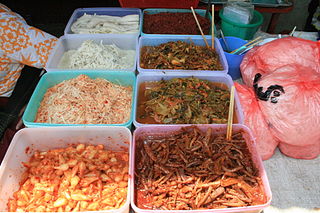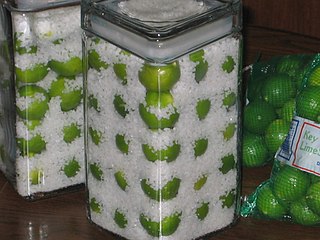See also
| Sauces |
| |
|---|---|---|
| Dips | ||
| Pickles and preserves | ||
| Spreads and pastes | ||
| Oils and liquids | ||
| Spices and powders | ||
| Salads | ||
| Salad dressings | ||
| Ketchups | ||
| Mustards | ||
| Vinegars | ||
| List articles | ||
| Accoutrements | ||
The following is a partial list of condiments used in Pakistani cuisine:
Achar are made from certain varieties of vegetables and fruits that are finely chopped and marinated in brine or edible oils along with various spices. Some varieties of fruits and vegetables are small enough to be used whole. Some regions also specialize in pickling meats and fish.
Chutney is a family of condiments associated with South Asian cuisine made from a highly variable mixture of spices, vegetables, or fruit.

A chutney is a spread in the cuisines of the Indian subcontinent. Chutneys are made in a wide variety of forms, such as a tomato relish, a ground peanut garnish, yogurt or curd, cucumber, spicy coconut, spicy onion or mint dipping sauce.

Mixed pickles are pickles made from a variety of vegetables mixed in the same pickling process. Mixed pickles are eaten much like other pickles: in small amounts to add flavor and to accent a meal. Mixed pickles appear in many different world cuisines.

Trinidad and Tobago cuisine is the cuisine of the Caribbean island state of Trinidad and Tobago. It reflects a fusion of African, Creole, Indian-South Asian, Chinese, Amerindian, Arab, European, and Latin American-Spanish-Portuguese cuisines.

Sri Lankan cuisine is known for its particular combinations of herbs, spices, fish, vegetables, rices, and fruits. The cuisine is highly centered around many varieties of rice, as well as coconut which is an ubiquitous plant throughout the country. Seafood also plays a significant role in the cuisine, be it fresh fish or preserved fish. As a country that was a hub in the historic oceanic silk road, contact with foreign traders brought new food items and cultural influences in addition to the local traditions of the country's ethnic groups, all of which have helped shape Sri Lankan cuisine. Influences from Indian, Indonesian and Dutch cuisines are most evident with Sri Lankan cuisine sharing close ties to other neighbouring South and Southeast Asian cuisines.

Pickling is the process of preserving or extending the shelf life of food by either anaerobic fermentation in brine or immersion in vinegar. The pickling procedure typically affects the food's texture and flavor. The resulting food is called a pickle, or, to prevent ambiguity, prefaced with pickled. Foods that are pickled include vegetables, fruits, meats, fish, dairy and eggs.

The generic term for condiments in the Filipino cuisine is sawsawan. Unlike sauces in other Southeast Asian regions, most sawsawan are not prepared beforehand, but are assembled on the table according to the preferences of the diner.

A South Asian pickle, known as pacchadi, achar, athanu, loncha, oorugai, or avakaai in the South, is a pickled food, native to the Indian subcontinent, made from a variety of vegetables and fruits, preserved in brine, vinegar, or edible oils along with various Indian spices.

Nepali/Nepalese cuisine comprises a variety of cuisines based upon ethnicity, soil and climate relating to Nepal's cultural diversity and geography. Dal-bhat-tarkari is eaten throughout Nepal. Dal is a soup made of lentils and spices, served over boiled grain, bhat—usually rice but sometimes another grain - and a vegetable soup, tarkari. Condiments are usually small amounts of spicy pickle which can be fresh or fermented, and of which there are a considerable number of varieties. Other accompaniments may be sliced lemon (nibuwa) or lime (kagati) with fresh green chilli and a fried papad. Dhindo (ढिंडो) is a traditional food of Nepal.

South Indian cuisine includes the cuisines of the five southern states of India—Andhra Pradesh, Karnataka, Kerala, Tamil Nadu and Telangana—and the union territories of Lakshadweep, Pondicherry, and the Andaman and Nicobar Islands.There are typically vegetarian and non-vegetarian dishes for all five states. Additionally, all regions have typical main dishes, snacks, light meals, desserts, and drinks that are well known in their respective region.

Mohnyin Tjin, is a popular Burmese cuisine fermented food dish of vegetables preserved in rice wine and various seasonings. It is similar to Korean Kimchi and Japanese Takana Tsukemono. Mohnyin Tjin is popularly associated with the Shan and is a ubiquitous condiment for Shan dishes such as meeshay and shan khauk swè.

Telugu cuisine is a cuisine of South India native to the Telugu people from the states of Andhra Pradesh and Telangana. Generally known for its tangy, hot and spicy taste, the cooking is very diverse due to the vast spread of the people and varied topological regions.

Malaysian Indian cuisine, or the cooking of the ethnic Indian communities in Malaysia consists of adaptations of authentic dishes from India, as well as original creations inspired by the diverse food culture of Malaysia. Because the vast majority of Malaysia's Indian community are of South Indian descent, and are mostly ethnic Tamils who are descendants of immigrants from a historical region which consists of the modern Indian state of Tamil Nadu and Sri Lanka's Northern Province, much of Malaysian Indian cuisine is predominantly South Indian inspired in character and taste. A typical Malaysian Indian dish is likely to be redolent with curry leaves, whole and powdered spice, and contains fresh coconut in various forms. Ghee is still widely used for cooking, although vegetable oils and refined palm oils are now commonplace in home kitchens. Before a meal it is customary to wash hands as cutlery is often not used while eating, with the exception of a serving spoon for each respective dish.

Pickled fruit refers to fruit that has been pickled. Pickling is the process of food preservation by either anaerobic fermentation in brine or immersion in vinegar. Many types of fruit are pickled. Some examples include peaches, apples, crab apple, pears, plums, grapes, currant, tomato and olives. Vinegar may also be prepared from fruit, such as apple cider vinegar.

Acar is a type of vegetable pickle of Maritime Southeast Asia, most prevalent in Indonesia, Malaysia, Singapore and Brunei. It is a localised version of Indian achar. It is known as atjar in Dutch cuisine, derived from Indonesian acar. Acar is usually prepared in bulk as it may easily be stored in a well-sealed glass jar in refrigerator for a week, and served as the condiment for any meals.

Kasundi is the Asian or Bengali variety of mustard sauce or relish. It has the pungent paste of fermented mustard seeds, spices and sometimes dried mangoes, dried Indian plum and olives. Kasundi is popular as a dipping sauce in Bengali cuisine.